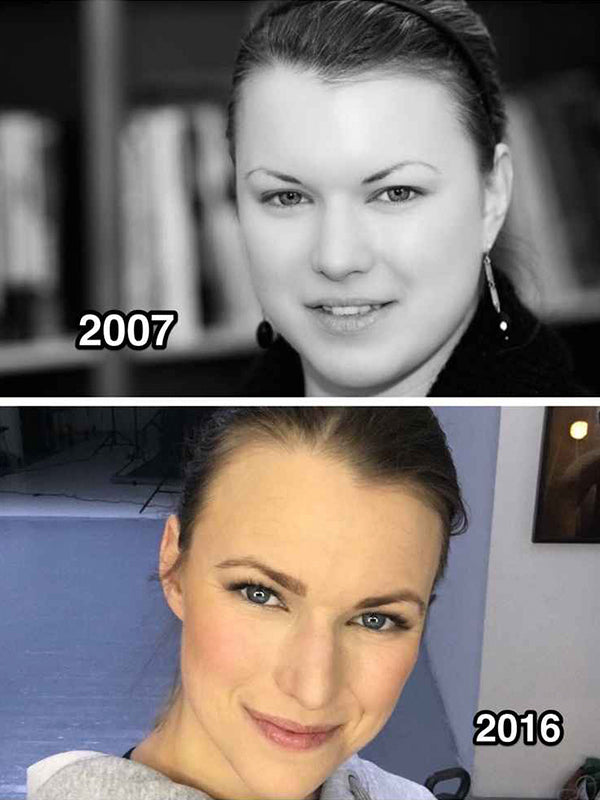
THIS IS WHAT I LOOKED LIKE 10 YEARS AGO
You might not believe it.
But the pictures speak the truth.
Well, actually, not quite - because the picture from 2007 was photoshopped by my sweet former colleague Mads, who realised how sad I would be about the new portrait for the company website.
So he removed the dark circles and bags under my eyes as best he could.
And the red bumps all over my face.
I think he also took a bit off the chin and cheeks.
And yay for the black and white filter.
(The 2016 image is an untouched selfie, only the lashes are dolled up).
LOW METABOLISM OR AUTO-IMMUNE CONDITION!
So what story are these images telling? One that even photoshop couldn't change?
2007:
- The almost disappearing eyebrows.
- Fluid build-up on the face (and body).
- Dull eyes and immense tiredness.
- Dry hair that fell out in clumps.
- Uncontrollable appetite and consequent weight gain (around 10kg in a year's time).
And behind the picture:
- Constipation and thin stomach in turn.
- Severe abdominal pain.
- Crying fits bordering on hysterical - especially during physical exertion.
- Pain in all my joints.
- Exhaustion - which I tried to mask with a copious amount of energy drink from the morning.
- Memory loss.
- Anxiety attacks at the thought of the pile of tasks piling up.
- Volapyk leaving my lips instead of words, especially during (heavy) menstruation.
...probably a lot of other things I've happily repressed.

The before and after pictures could have been an account of how I suffered from undetected low metabolism in 2007. And how in 2016, after many years of struggle, I was finally diagnosed and given the right medication.
This is NOT the story i want to tell.
In 2006, there was no focus on metabolic disorders.
Nor was there any focus on adrenal fatigue, which was on many people's lips before low metabolism.
I'm actually kind of happy about that, with the knowledge and experience I have now. That I didn't put a label on how I felt.
And you know what?
Maybe my blood tests would have shown low metabolism or an auto-immune condition if I had had the doctor do some extended tests back then. (The normal tests didn't really show anything).
But I didn't.
To be honest, I didn't like it that much.
A year after the before picture was taken, I went down with the flag.
Didn't make it out the door or to work.
I dissolved into tears and went to bed.
(I can't believe I actually lasted a whole year with those symptoms before my body completely shut down. I just tried to hang in there as best I could. It hadn't even occurred to me that it was both necessary and possible to change anything about my life).
The following months passed in a haze.
I slept. A LOT.
I got to the gym, but couldn't work out at all.
So I alternated between lying down on a foam roller and standing and doing some mobility exercises for my feet and hands and neck and jaw. It could take me 1.5 hours to get through a few simple exercises because I had to take breaks in between and lie down.
My really lovely husband (ed. Jacob Søndergaard), who at first couldn't understand how and why I felt that way, was very supportive and solution-orientated.
So he started reading the physiology books.
These two books in particular, which are now permanently on my desk and which I regularly return to in my work with clients.
"Why Zebras Don’t Get Ulcers"

and
“The Endocrine System in Sports and Exercise”

And then he read some passages about how the HPA-axis (the connection between the hypothalamus and pituitary gland in the brain - and then the adrenal glands) works under stress - and that started to explain a lot of those symptoms.
(Incidentally, it is the brain that responds to elevated cortisol levels secreted by the adrenal glands that chooses to turn down the signals that stimulate cortisol production in the adrenal glands. Not the adrenal glands getting tired. It's the brain that switches off the switch in an attempt to restore homeostasis, the natural balance. Just had to clarify.
THE EXPLANATION WAS SIMPLE. MY SYSTEM WAS HEAVILY OVERLOADED
My body wanted to, but COULD NOT co-operate with me anymore.
There was actually nothing wrong with me.
My body was showing a perfectly normal reaction to what it had been exposed to for a number of years leading up to my collapse.
And I was lucky that I snapped and pulled the plug completely before I hit the physiological point of no return. The point where my symptoms didn't go away, but instead turned into a chronic condition that required medical treatment.
The way back was the opposite of what I had been doing many, many years before.
- Forget about more than one appointment a day.
- Forget about heavy weights.
- Forget about anything that got my heart rate up.
- Forget about trying to cut down on carbs and chocolate in an attempt to tame the fat deposits.
- Forget about going back to my old project management job (my stress collapse is the reason you're reading this email, which I can't help but write because I'm working on what I truly love in a way that empowers me every single day).
So what did I do?
- I had to take one day at a time.
- I had to have peace. A lot of quiet.
- I had to take morning, midday and afternoon naps.
- I had to eat regular meals.
- I had to make peace with cancelling social events 9 out of 10 times.
What I struggled with the most was that it took my brain over 1.5 years to get back to the usual relatively sharp level where I could think beyond one decision at a time. So I read up on a number of supplements that I could take to get my cognitive function back, and that's when things started to move a little faster in the right direction.
While I was repairing my brain, I had to make peace with replacing non-fiction with Swedish crime novels for a long period of time. It wasn't as frustrating to forget the plot there - I could read them again with the same initial excitement.
But most importantly. I had to let go of the idea of losing fat and looking like a fitness girl (all year round).
This had been my dream for many, many years after I started strength training and hanging out in the whole body-fixated fitness community.
The fitness community that cheered loudly when I was running my body into the ground with crazy workouts and dieting attempts with a demanding job on the side (it was "cool") - and who only had scornful comments to spare when I went down with the flag.
I'm glad it wasn't until many years later that I randomly came across a comment somewhere online about how ridiculous it was that I had started working in health when I was the kind of person who couldn't cope and "probably couldn't even wipe my own arse" (because it's not cool to show signs of weakness).
Well, I certainly couldn't do what it took to get into bikini shape with a body fat percentage of 13%, so I put that plan on hold.
Because I couldn't let go of the dream completely - and only realised years later that there was no way I was ready to pay the price it would cost me.
MY BODY STARTED TO CO-OPERATE
Immediately after I crashed and started taking care of myself - in that almost banal way - I lost a lot of fluid.
So my body was already starting to repair itself and get back to my normal figure.
But it took 2-3 years of...
- practising opting out of tasks and relationships that drained me - and opting in to those that strengthened me
- working with my all or nothing mindset
- regularly prioritising my sleep and rest
- adequate amounts of nutritious food,
- appropriate amount of exercise
- with appropriate interspersed exercise-free periods
...before my body got in really good shape.
The development was always slow and steady, but as soon as I pushed the envelope, I fell back a little.
So I had to learn to accept that.
Not to force the process.
Not to put impossible demands on myself for perfection.
Not be seduced by drastic strategies to shed the fat that had crept up on me all those years leading up to my stress collapse.
Fast forward to the year 2017.....
I'VE GOT MY BODY BACK
No, scratch that. I have a body that I didn't even have before. Stronger, more resilient. More appreciated.

- I furthered my education in applied neurology, physiology and psychology - and the delicate interplay between brain and body.
- I understood the concept of the appropriate disorder.
- I learnt how to exercise and eat on the day.
- I learnt to downscale and upscale - and adapt the plan to my life, not the other way around.
- I learnt that progress is not linear, but comes in waves.
- I learnt that it's not about never falling off the horse - it's about forgiving yourself and getting back on.
- I learnt that you can go further without succumbing when you surround yourself with loving people with the same basic core values (special thanks go to my super team of now 26 dedicated and talented people - together we are stronger!
And at the time of writing, I - and my team - have taught just over 6,000 women how to not only bounce back, but also go further after the tough times.
Less worn out. More empowered. In mind and body.
And we can help you too.
"But Anna, what about my reflection?"
I can SO understand how you can look at your reflection in the mirror and see yourself angry and sad. And think: "Now, NOW I have to do something about it. Remove what shouldn't be there".
Maybe you feel like going on a diet or sweating it away.
But I want to invite you behind the reflection.
What story does it tell?
What has happened in your life that has shaped your face and body into what you see in the mirror right now?
What do you need to repair?
...rebuild?
...nourish?
...give attention?
...take loving care of?
...say goodbye to?
Then what you want to remove from your reflection will be replaced with a result of the respect, recognition and the appreciation you give your body.
Your reflection, your radiance, your images will begin to bear the signs that you are looking after yourself.








